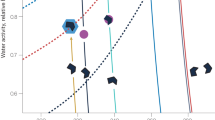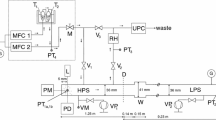Abstract
Nucleation rates for droplet formation in water vapor are measured in molecular dynamics (MD) simulations of SPC/E and TIP4P/2005 water by monitoring individual nucleation events. The nucleation process is simulated in the NPT ensemble to evaluate the steady-state nucleation rate in accordance with the assumptions of classical nucleation theory (CNT). Nucleation rates measured between 300 and 425 K for the SPC/E model, and between 325 and 475 K for the TIP4P/2005 model, agree with the CNT predictions roughly within the standard deviation of the MD measurements of the nucleation rates.











Similar content being viewed by others
Data availability
The data that support the findings of this work are available from the corresponding author upon request.
References
Berendsen HJC, Grigera JR, Straatsma TP (1987) The missing term in effective pair potentials. J Phys Chem 91(24):6269–6271. https://doi.org/10.1021/j100308a038
Abascal JLF, Vega C (2005) A general purpose model for the condensed phases of water: TIP4P/2005. J Chem Phys 123(23):234505. https://doi.org/10.1063/1.2121687
Matsubara H, Koishi T, Ebisuzaki T, Yasuoka K (2007) Extended study of molecular dynamics simulation of homogeneous vapor-liquid nucleation of water. J Chem Phys 127(21):214507. https://doi.org/10.1063/1.2803899
Sepehri A, Amjad-Iranagh S, Golzar K, Modarress H (2013) Homogeneous and heterogeneous nucleation of water vapor: a comparison using molecular dynamics simulation. Chem Phys 423:135–141. https://doi.org/10.1016/j.chemphys.2013.07.005
Zhang C, Wang Y, Liu Y, Yang Y (2015) A molecular dynamics study of water vapor nucleation in the presence of ions. Chem Eng Sci 137:308–319. https://doi.org/10.1016/j.ces.2015.06.006
Tanaka KK, Kawano A, Tanaka H (2014) Molecular dynamics simulations of the nucleation of water: determining the sticking probability and formation energy of a cluster. J Chem Phys 140(11):114302. https://doi.org/10.1063/1.4867909
Angélil R, Diemand J, Tanaka KK, Tanaka H (2015) Homogeneous SPC/E water nucleation in large molecular dynamics simulations. J Chem Phys 143(6):064507. https://doi.org/10.1063/1.4928055
Pérez A, Rubio A (2011) A molecular dynamics study of water nucleation using the TIP4P/2005 model. J Chem Phys 135(24):244505. https://doi.org/10.1063/1.3672063
Duška M, Němec T, Hrubý J, Vinš V, Planková B (2015) Molecular dynamics simulation of vapour-liquid nucleation of water with constant energy. In: Dančová P, Vít T (eds.) EPJ Web Conf., vol. 92, 02013. https://doi.org/10.1051/epjconf/20159202013
Dumitrescu LR, Smeulders DMJ, Dam JAM (2017) Gaastra-Nedea SV Homogeneous nucleation of water in argon. Nucleation rate computation from molecular simulations of TIP4P and TIP4P/2005 water model. J Chem Phys 146(8), 084309. https://doi.org/10.1063/1.4975623
Hrubý J, Duška M, Němec T, Kolovratník M (2018) Nucleation rates of droplets in supersaturated steam and water vapour-carrier gas mixtures between 200 and 450 K. Proc. Inst. Mech. Eng. Part A J. Power Energy 232(5), 536–549. https://doi.org/10.1177/0957650918770939
Yasuoka K, Matsumoto M (1998) Molecular dynamics of homogeneous nucleation in the vapor phase. II. Water. J Chem Phys 109(19):8463–8470. https://doi.org/10.1063/1.477510
Wyslouzil BE, Wölk J (2016) Overview: homogeneous nucleation from the vapor phase—the experimental science. J Chem Phys 145(21):211702. https://doi.org/10.1063/1.4962283
Wölk J, Strey R, Heath CH, Wyslouzil BE (2002) Empirical function for homogeneous water nucleation rates. J Chem Phys 117(10):4954–4960. https://doi.org/10.1063/1.1498465
Todorov IT, Smith W, Trachenko K, Dove MT (2006) DL_POLY_3: new dimensions in molecular dynamics simulations via massive parallelism. J Mater Chem 16(20):1911. https://doi.org/10.1039/b517931a
www.nist.gov (2018) SAT-TMMC: liquid-vapor coexistence properties - SPC/E water (LRC). Accessed December 10, 2018 https://www.nist.gov/mml/csd/informatics/sat-tmmc-liquid-vapor-coexistence-properties-spce-water-lrc
Kadaoluwa Pathirannahalage SP, Meftahi N, Elbourne A, Weiss ACG, McConville CF, Padua A, Winkler DA, Costa Gomes M, Greaves TL, Le TC, Besford QA, Christofferson AJ (2021) Systematic comparison of the structural and dynamic properties of commonly used water models for molecular dynamics simulations. J Chem Inf Model 61(9):4521–4536. https://doi.org/10.1021/acs.jcim.1c00794
Kalikmanov VI (2013) Nucleation Theory. Lecture Notes in Physics, vol. 860. Springer, Dordrecht. https://doi.org/10.1007/978-90-481-3643-8
Vega C, de Miguel E (2007) Surface tension of the most popular models of water by using the test-area simulation method. J Chem Phys 126(15):154707. https://doi.org/10.1063/1.2715577
Vega C, Abascal JLF, Nezbeda I (2006) Vapor-liquid equilibria from the triple point up to the critical point for the new generation of TIP4P-like models: TIP4P/Ew, TIP4P/2005, and TIP4P/ice. J Chem Phys 125(3):034503. https://doi.org/10.1063/1.2215612
Funding
This work was supported by the Institute of Thermomechanics (RVO:61388998) and by the Czech Ministry of Education, Youth and Sports under project no. LTV19017. Access to computing and storage facilities owned by parties and projects contributing to the National Grid Infrastructure MetaCentrum provided under the program “Projects of Large Research, Development, and Innovations Infrastructures” (CESNET LM2015042) is also appreciated (\(\sim\) 300 thousand CPU hours).
Author information
Authors and Affiliations
Contributions
The author confirms sole responsibility for the following: study conception and design, realization of numerical experiments, data collection, analysis and interpretation of results, and manuscript preparation. The author thanks Michal Duška for sharing his cluster evaluation scripts.
Corresponding author
Ethics declarations
Competing interests
The author declares no competing interests.
Appendices
Appendix 1. Classical nucleation theory overview
The following Eqs. (A1)–(A7) summarize the formulas of the classical nucleation theory (CNT) for the case of unary homogeneous nucleation of droplets. A thorough derivation of the formulas governing the nucleation parameters can be found in nucleation textbooks, e.g., Kalikmanov [18]. The nucleation parameters reflect the thermophysical state of the nucleating parent phase characterized by pressure p and temperature T. Within the CNT model, these two parameters are assumed constant during the nucleation process, and the required thermophysical properties of water are being evaluated at the nucleation pressure and temperature.
The nucleation work \(\Delta G\) (J) within CNT is a function of the cluster size given by the number of molecules n
where \(v_l\) (m\(^{3}\)) is molecular volume of water molecules in the liquid phase, \(p_{sat}\) (Pa) is the saturation pressure of water, and \(\sigma\) (N/m) is the surface tension.
The energy barrier to nucleation denoting the maximum of the nucleation work (A1), i.e., the critical nucleation work \(\Delta G ^{\star }\), takes the form
The critical cluster size, conveniently expressed as the number of molecules in the critical cluster \(n^{\star }\), is calculated as
The nucleation rate J (m\(^{-3}\)s\(^{-1}\)), representing the number of droplets crossing the critical size and growing to macroscopic proportions, is given by
where the pre-exponential factor \(J_0\) (m\(^{-3}\)s\(^{-1}\)) is evaluated as
which is a product of the non-equilibrium (Zeldovich) factor Z, impingement rate of monomers onto the cluster surface \(\beta\) (m\(^{-2}\)s\(^{-1}\)), surface area of the critical cluster \(A^{\star }\) (m\(^2\)), and water vapor number density \(\rho _v\) (m\(^{-3}\)), which is calculated as a product of supersaturation ratio \(p/p_{sat}\) and saturation vapor density \(\rho _{sat,v}(T)\) (m\(^{-3}\)).
The Zeldovich factor in Eq. (A5) takes the form
and the impingement rate \(\beta\) (m\(^{-2}\)s\(^{-1}\)) is calculated as
To sum up, CNT allows us to predict a steady-state nucleation rate in metastable water vapor, which is a kinetic property of the macroscopic parent system at a pressure p and temperature T. The CNT relations utilize the following four thermophysical properties of macroscopic water substance:
-
Surface tension \(\sigma (T)\)
-
Saturation pressure \(p_{sat}(T)\)
-
Saturated vapor number density \(\rho _{sat,v}(T)\)
-
Liquid number density \(\rho _{l}(T)\)
The above thermophysical properties of the SPC/E and TIP4P/2005 water models are summarized in Appendices 4 and 5, respectively.
Appendix 2. Impingement rate evaluation from cluster growth data
The procedure to deduce the average impingement rate of vapor molecules attaching onto the cluster surface from molecular simulation data is based on the calculation of instantaneous growth and decay of the maximum cluster during the cluster growth stage. Assuming a constant impingement rate \(\beta _{MD}\) (m\(^{\mathrm {-2}}\) s\(^{\mathrm {-1}}\)) and a single supercritical growing cluster, the cluster growth can be described as a change of the number of cluster molecules n over time t in the following manner
where the right-hand side of Eq. (B8) represents the cluster surface area multiplied by the impingement rate. Differential equation (B8) can be readily integrated and its solution takes a simple form
Finally, the parameters \(C_0\) and \(t_0\) can be evaluated by fitting the cubic function (B9) to the cluster growth data from MD simulation, i.e., number of cluster molecules vs. simulation time (as shown in Figure 5, blue line), during the growth stage of the simulation run. The fitted value of \(C_0\) is then related to the impingement rate \(\beta _{MD}\) as
Appendix 3. Nucleation work evaluation from cluster distribution data
The procedure to evaluate the nucleation work \(\Delta G_{MD}\) as a function of cluster size n from cluster size distribution has been described in previous MD nucleation studies of water nucleation [3, 9, 12]. In this work, the cluster size distribution is calculated from saved configurations of all simulation runs in the MD simulations set, which in our case consisted of 20 simulation runs. For cluster size n, the nucleation work is a function constrained-equilibrium distribution of clusters
where the constrained-equilibrium distribution \(\rho _{eq}\) is related to the steady-state distribution \(\rho\) through a recursive relation [18]
The steady-state distribution \(\rho (n)\) is the actual cluster distribution observed in MD simulation and is therefore calculated
where i denotes the simulation run and j denotes the j-th configuration within run i out of its total \(C_i\) saved configurations. Furthermore, \(c_{ij}(n)\) is the number of clusters of size n found in configuration j of run i, and \(V_{MD,ij}\) is the volume of the simulation cell in configuration j of run i.
Note that to solve Eq. (C12) for \(\rho _{eq}(n)\), two of the nucleation parameters, \(J_{MD}\) and \(\beta _{MD}\), need to be known in advance. Indeed this is the case, since both parameters are measured in our MD simulations independently. However, any errors in measuring \(J_{MD}\) or \(\beta _{MD}\) will inevitably lower the accuracy of evaluating \(\Delta G_{MD}\).
Appendix 4. Thermophysical properties of SPC/E water
Parametrizations of thermophysical properties of SPC/E water valid for the temperature range 300–425 K are summarized below.
Surface tension \(\sigma\) (N/m) was parametrized by Vega and Miguel [19] as
where \(s_1\) = 0.20532, \(s_2\) = 0.6132, and \(T_c\) = 625.7.
Saturation pressure \(p_{sat}\) (Pa) data reported by NIST [16] have been fitted to an Antoine-type of function
where \(p_1\) = 12.74080, \(p_2\) = −4712.723, and \(p_3\) = −25.67480.
Saturated vapor density \(\rho _{sat,v}\) (m\(^{-3}\)) data reported by NIST [16] have been fitted to a polynomial function in exponent as
where \(a_0\) = 2.855\(\times\)10\(^{1}\), \(a_1\) = −2.897\(\times\)10\(^{4}\), \(a_2\) = 1.304\(\times\)10\(^{7}\), \(a_3\) = −3.116\(\times\)10\(^{9}\), and \(a_4\) = 2.722\(\times\)10\(^{11}\).
Liquid density \(\rho _{l}\) (m\(^{-3}\)) data reported by NIST [16] have been fitted to a polynomial function
where \(b_0\) = −4.686\(\times\)10\(^{3}\), \(b_1\) = 7.169\(\times\)10\(^{6}\), \(b_2\) = −3.533\(\times\)10\(^{9}\), \(b_3\) = 7.954\(\times\)10\(^{11}\), and \(b_4\) = −6.815\(\times\)10\(^{13}\).
Appendix 5. Thermophysical properties of TIP4P/2005 water
Parametrizations of thermophysical properties of TIP4P/2005 water valid for the temperature range 325–475 K follow below.
Surface tension \(\sigma\) (N/m) was parametrized by Vega and Miguel [19] as Eq. (D14), where \(s_1\) = 0.22786, \(s_2\) = 0.6413, and \(T_c\) = 641.4.
Saturation pressure \(p_{sat}\) (Pa) data reported by Vega et al. [20] have been fitted to an Antoine-type of function (D15), where \(p_1\) = 12.46120, \(p_2\) = −4476.552, and \(p_3\) = −41.49840.
Saturated vapor density \(\rho _{sat,v}\) (m\(^{-3}\)) data reported by Vega et al. [20] have been fitted to function Eq. (D16), where \(a_0\) = 3.578\(\times\)10\(^{1}\), \(a_1\) = −3.935\(\times\)10\(^{4}\), \(a_2\) = 1.825\(\times\)10\(^{7}\), \(a_3\) = −4.216\(\times\)10\(^{9}\), and \(a_4\) = 3.526\(\times\)10\(^{11}\).
Liquid density \(\rho _{l}\) (m\(^{-3}\)) data reported by Vega et al. [20] have been fitted to function Eq. (D17), where \(b_0\) = −5.385\(\times\)10\(^{3}\), \(b_1\) = 8.130\(\times\)10\(^{6}\), \(b_2\) = −3.958\(\times\)10\(^{9}\), \(b_3\) = 8.6345\(\times\)10\(^{11}\), and \(b_4\) = −7.067\(\times\)10\(^{13}\).
Rights and permissions
About this article
Cite this article
Němec, T. Nucleation parameters of SPC/E and TIP4P/2005 water vapor measured in NPT molecular dynamics simulations. J Mol Model 28, 174 (2022). https://doi.org/10.1007/s00894-022-05130-x
Received:
Accepted:
Published:
DOI: https://doi.org/10.1007/s00894-022-05130-x




